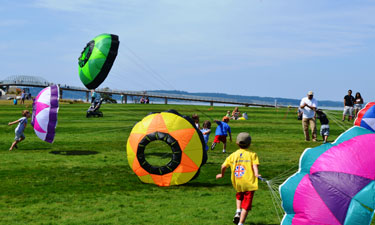 Along the edge of Washington’s Puget Sound lies Chambers Creek Regional Park, featuring soccer fields, an 18-hole golf course, walking trails, the award-winning Environmental Sciences Building and a “gigantic open space of lawn,” as described by Recreation Coordinator Chad Harvell. He recalls touring the park just after he was hired to his post in 2011 — it was a windy day, “and I thought, ‘We need a kite festival here. We have this beautiful, open space — how can we do this?’” Harvell did some research and was pleased to stumble upon the local Pierce County Kitefliers Association (PCKA), helmed by President Bob Wendt. The two struck up an easy correspondence, and it wasn’t long before they agreed to collaborate and the Kite Festival was born.
Along the edge of Washington’s Puget Sound lies Chambers Creek Regional Park, featuring soccer fields, an 18-hole golf course, walking trails, the award-winning Environmental Sciences Building and a “gigantic open space of lawn,” as described by Recreation Coordinator Chad Harvell. He recalls touring the park just after he was hired to his post in 2011 — it was a windy day, “and I thought, ‘We need a kite festival here. We have this beautiful, open space — how can we do this?’” Harvell did some research and was pleased to stumble upon the local Pierce County Kitefliers Association (PCKA), helmed by President Bob Wendt. The two struck up an easy correspondence, and it wasn’t long before they agreed to collaborate and the Kite Festival was born.
August 9, 2014, marked the event’s third year. “We had about 1,000 people participate,” Harvell says, audibly beaming. “Our first year, we had probably 500 people. The second year, maybe 550 — it’s grown every year.” The Kite Festival is free to attend and boasts some very cool activities, like PCKA’s kids kite-making workshops. “This year, about 300 kids got to make kites — we’re talking heavy plastic with a nice tail, a strong line of string and a wooden dowel handle… PCKA brings all the supplies,” Harvell says. He’s also cultivated a partnership with nearby Ocean Shores Kites, a well-known vendor of kites and kite-related items like windsocks, Frisbees and kids’ toys. Each year, they bring their high-quality products and expertise to the festival, as well as donate kites to a fun community raffle drawing. [“Ocean Shores Kites] drives a couple hours to come support us every year — it’s a great relationship,” says Harvell.
For the most part, visitors to the Kite Festival take advantage of the chance to casually enjoy a sunny, breezy day on the Sound, but there are some organized activities in which to take part, like “running with the bulls.” “It’s a term coined by the PCKA and the kite community,” Harvell explains. “The kids split into age groups and run races dragging these big kites. Whoever wins gets a prize.” Professional kite fliers — “I call them professional fliers; they say they’re just advocates,” Harvell interjects, laughing — also put on a show of kite acrobatics, maneuvering their colorful kites to choreographed routines, with music provided by an onsite emcee. “It’s a day where you see people hanging out in the park with their families. You see them enjoying themselves, enjoying the day, relaxing, watching people fly their kites — you tend to see them just kicking back with one another,” Harvell says. “It’s really nice to see that.”
Samantha Bartram is the Associate Editor of Parks & Recreation Magazine.

